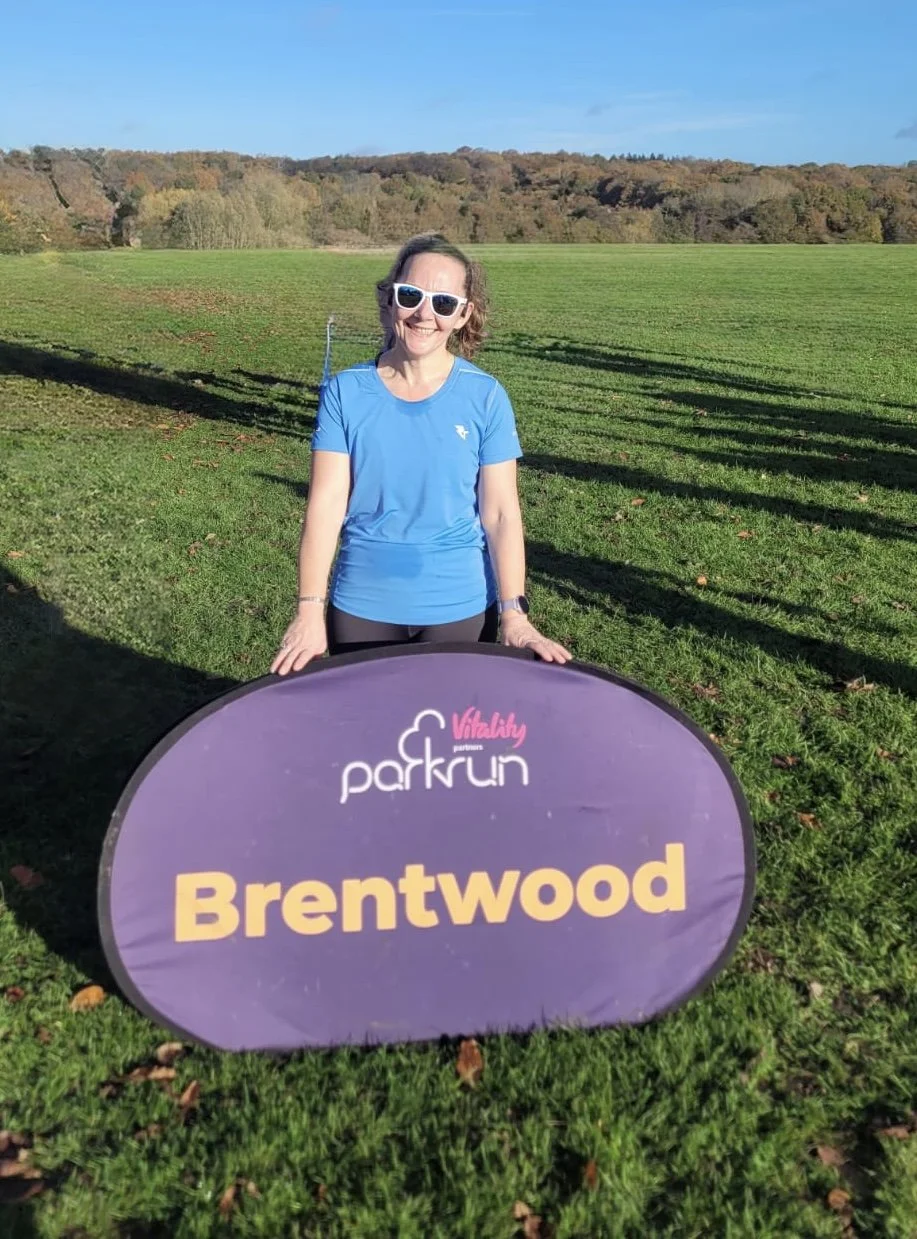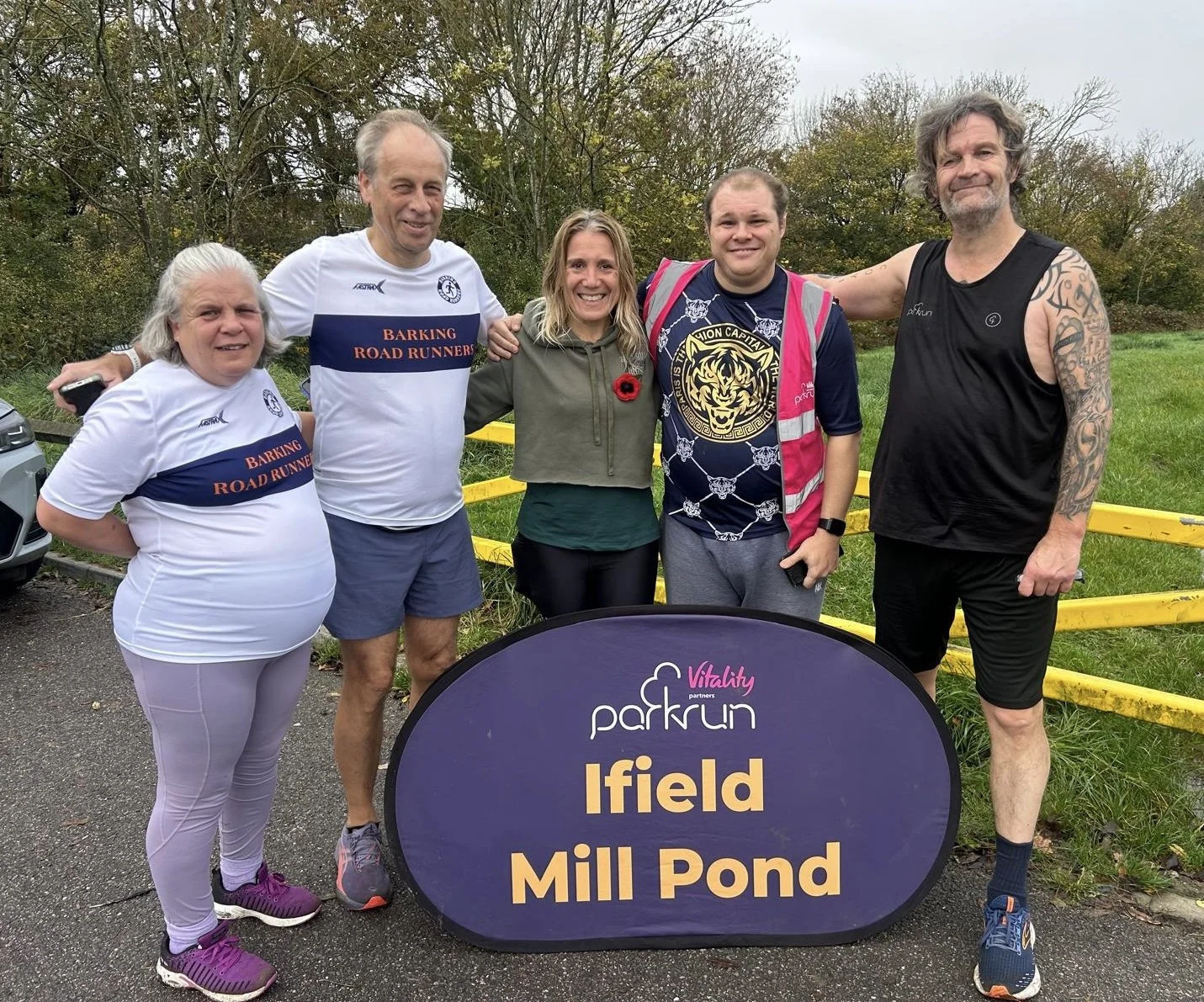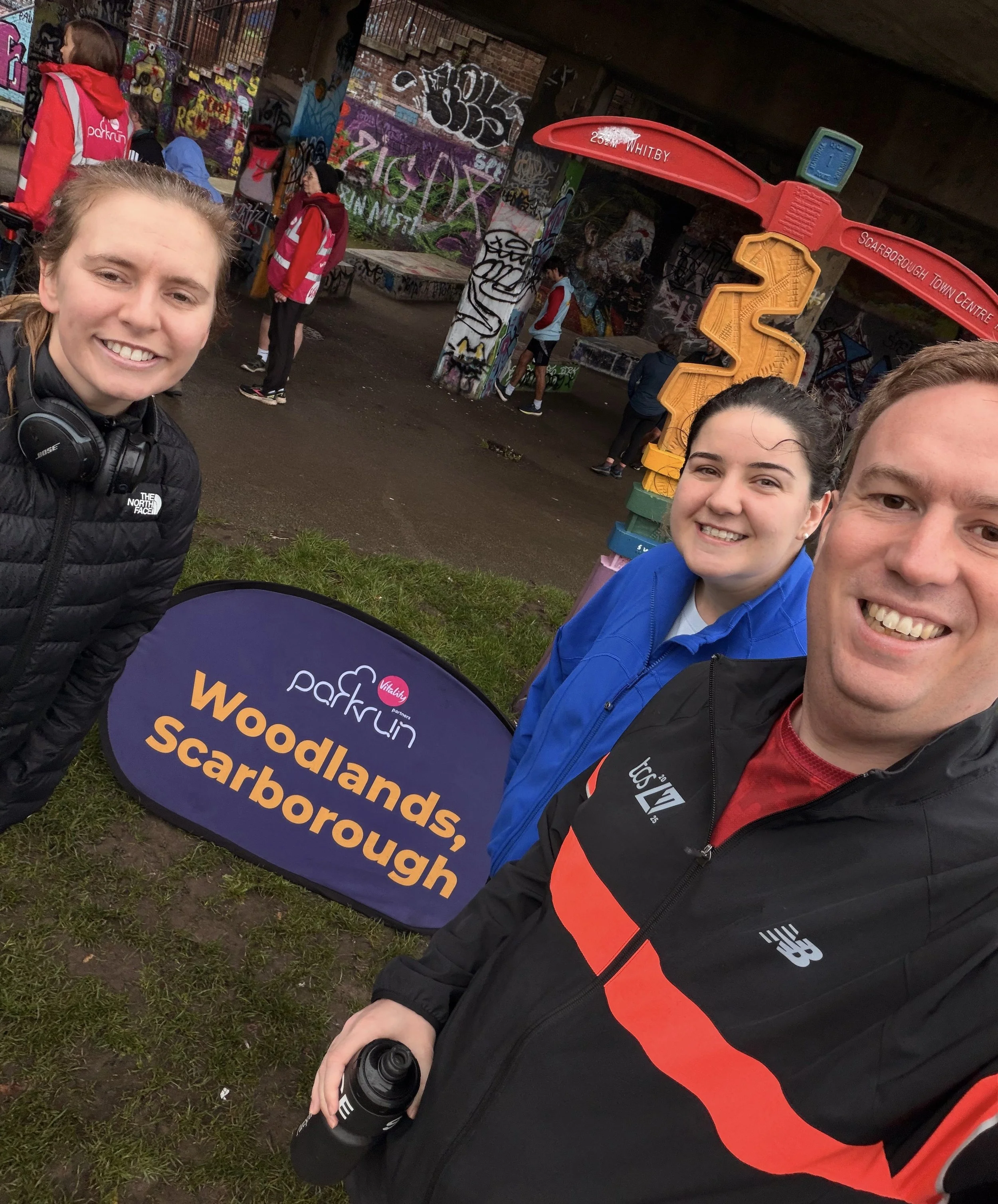BRR Blog - 10 November 2025
Howdie Road Runners!
No Club races this weekend, but a group of us still had fun at Greg’s orienteering/point-to-point event at Hainault Forest. Greg is planning to organise another event and I’d recommend you take part; getting a little bit lost is part of the fun, and you really can’t go far astray in Hainault Forest. We were in pairs and a threesome, so there was no risk of anyone being left alone. Elsewhere in Essex, Barry took part in the Rochford 10 miler. All the details in Greg’s Race Report.
But we start with some wise words from Zahra. I love the idea of the 10-minute rule!
Zahra’s Uni Unload
Darker nights. Bad weather. Early mornings. Winter is a time when motivation is likely to decrease; it might be the darker days or the colder mornings but, when your training for something, you need to keep that motivation high. There are two main types of motivation:
Intrinsic motivation is when you are motivated by internal factors like doing it to feel good like having runners high. This motivation type can lead to increased performance, persistence and enjoyment.
Extrinsic motivation is when you are motivated by external factors like getting praise or a medal (who doesn't love a medal ). When doing a big organised race, we may do it for the medals and goodies at the end, but when it comes to club races, you don't always get something so why do we do them? We do them because of how it makes us feel good whether it's runners high or a sense of achievement, and we are intrinsically motivated to race and run. So, next time you don't feel like going for a run, think about how you will feel afterward and - if all else fails focus - on the 10-minute rule. This is when you just run for 10 minutes and, after that, you can either stop or keep going. This can help you get on your feet, and you may decide to go for longer, which helps build consistency even when motivation is low.
Parkrun Boomerang
Have you heard about the parkrun boomerangs? In June 2024, Ally O’Rourke, a Run Director from Perth in Australia, bought a pack of 10 plastic boomerangs - numbered B1 to B10 - and handed them out at South Beach Recreation Reserve parkrun. They were then passed on to people who were doing a different parkrun the following week. They took care of it before posting a picture on the 10 Boomerangs Facebook page and passing it to someone else. And so on and so on. The boomerangs have now been on quite a journey, visiting Germany, Lithuania, Japan, Singapore, Italy, Poland, and the UK along the way. On the way, the Boomerangs have been given more exciting names (B8 is now called B8rtie) and customized and embellished.
Once a boomerang makes its way back to Australia, it can’t leave again, and when it reaches South Beach, it is retired. So far, five of the ten have retired, with only B9 still abroad, but O’Rourke has now launched a further batch (B11 to B20) at a special first anniversary event at Osterley parkrun in London.
I hadn’t actually heard of the boomerangs until I saw John M’s son, Robbie, with one - B20 - at the track last week. B20 seems to have already been to Sweden and the USA, amongst other places and, with Robbie planning to take it on a trip to Wales and hand it on there, its journey through nations continues.
Robbie Mitchell with B20
What to do in the Event of a Seizure
You may be aware of the incident that took place at Barking parkrun on Saturday. A parkrun tourist, a very seasoned runner, had a seizure just after crossing the finish line, unfortunately falling forward and causing herself a lot of facial injuries. It was a shock for all those present, including the woman in question, who told us afterwards that she had been seizure-free since the 1990s.
As you’d expect, the parkrunners rallied around and looked after her superbly while we waited for the ambulance (thanks to them, and also to the volunteers who kept calm and carried on, leaving space for the people who were tending the patient). Checking on the NHS website afterwards, I was pleased to see that we had taken the appropriate action. If in doubt, here is what you should do in a similar circumstance:
Advice on action to take if someone has a seizure
Better than the Average parkrunner?
There was an interesting article on the Runner’s World website about the average age of parkrunners.
One of the joys of running is that you can take it up, or return to it, whatever your age. And, with consistent training, you can even get quite good at it! Parkrun uses an age-grading system, so you can compare your performance with other people of your age and sex, so you are comparing like-with-like. But how does the age-grading system work?
The calculation is as follows:
(world record for your age and sex / your time) x 100 = age-grade percentage.
The higher the percentage, the better your relative performance. These correspond roughly to the following:
100% – a performance very close to the world record
90% – world-class performance
80% – national-class performance
70% – regional-class performance
60% – local-class performance
Don’t be despondent if your parkrun times give you an age grade score lower than these percentages. Always remember, if you are running at all, you are better than the average person and it will be having a positive impact on your health and fitness.
But what is the age of the average parkrunner? A study in 2018 found the mean average age of parkrunners across the global population is approximately 40.5 years. The age distribution varies by region and specific location. For example, university towns might tend to skew younger. The recent running boom, which has seen more younger people take up the sport since lockdown, may mean that the current average age is lower. We will have to wait for the next study to find out.
A to Z of Running
Episode thirteen in the A-Z of running, and this week it is brought to you by the letter ‘M.’ Marvellous!
🏃 Marathon: For anyone who has ever been asked ‘how long was that marathon?’, it’s a long-distance race of 42.195 kilometres (26.2 miles).
🧊 Massage: A recovery technique used to relieve muscle tension, improve circulation, and reduce soreness, particularly useful after long runs and races. You can do-it-yourself with foam rollers or massage guns, or get a professional sports massage.
🧪 Maximal Oxygen Uptake (VO₂ Max): The maximum amount of oxygen your body can use during intense exercise—a key indicator of aerobic fitness. Interval training can help improve VO₂ max.
🧠 Mental Toughness: The psychological resilience and focus required to push through discomfort, fatigue, and adversity during training or racing.
🧱 Metatarsals: the five long bones in the midfoot that connect the toes to the ankle. They play a crucial role in propulsion and shock absorption, especially during walking, running, and jumping. But they are prone to injury including stress fracture. Foot exercises like toe curls and towel scrunches can strengthen the muscles to support the metatarsals.
🧍 Midfoot Strike: A running gait where the middle of the foot contacts the ground first, rather than the heel or forefoot. A midfoot strike is thought to reduce impact forces.
Midsole: a layer of material between the inner and outer soles of a running shoe, for absorbing shock.
🧮 Mileage: the total distance run over a given period, usually measured weekly. You should increase mileage gradually to avoid injury.
Minimalist running shoes: shoes with a lower heel drop than conventional running shoes, which have a heel drop typically between 8mm to 12mm higher than the forefoot. In minimal running shoes, the offset is between zero and 6mm, to discourage heavy landing at the heel and to move you towards a more mid-foot or forefoot strike. If you want to try minimalist shoes but are used to running in normal shoes, it is important that you make the change gradually, to allow your feet to adapt, or you risk injury.
Mixed Terrain: running on varied and different surfaces, including trails and unpaved roads.
🧘 Mobility: The ability of joints and muscles to move freely and efficiently. Incorporating dynamic stretches and mobility drills (e.g. leg swings, hip circles) into your warm-up and cool-down routines can help improve mobility.
Motion Control: a type of running shoe built for support. They’re specifically designed to counteract excessive inward rolling of the foot —called overpronation — by providing firm structural support on the medial side of the shoe (this is the area of your foot that faces the other side). This reduced excess strain on the tissues, ligaments, tendons, and muscles of the feet and lower legs as the foot is held in proper alignment. But they tend to be stiffer and heavier than other shoes.
🧤 Muscle Memory: The ability of muscles to perform movements automatically after repeated practice. Regular drills and technique work help reinforce efficient movement patterns.
Greg’s Race Report
A change of pace for members of Barking Road Runners this week as they had a race with a difference at Hainault Country Park. Instead of speed or time this race would be decided on efficiency in covering the approximately 5-mile course in the shortest distance they could. The runners had to travel to a series of landmarks around the park and take photos to prove they had reached them, starting and finishing at the Global Cafe. The winning pair of Emma Paisley and Dennis Spencer-Perkins managed to complete the course in 5.2 miles narrowly beating Belinda Riches, Paul Withyman, and Steve Colloff who were second with Alison Fryatt and Martin Mason in third place after a technical failure.
Emma, Dennis, and friend…
Barry Rowell ran in the Rochford Remembrance Sunday 10. Starting and finishing in Rochford Square, the race passed the War Memorial before heading out into the surrounding villages and returning to the heart of town. Barry finished in a time of 1:41:42.
Barry at the Rochford Remembrance Day 10
BRR parkrunners
Barking - Dominic Herring 21:53, Rosie Fforde 24:15, John Mitchell 24;32, Cristina Cooper 25:23, Chris Muthaka 26:06, Daniel Plawiak 28:02, Jason Li 28:59, Nikki Cranmer 30:23, Andy Hiller 31:19, John Lang 31:28, Martin Mason 32:36, Faye Spooner 37:23, and Alan Murphy 50:12.
Brentwood - Louise Chappell 33:40.
Louise at Brentwood parkrun
Brook Leys - Sunny Bulchandani 24:09.
Burnham and Highbridge - Rob Courtier 32:44.
Harrow Lodge - Rory Burr 26:48.
Ifield Mill Pond - Belinda Riches 26:42, Barry Rowell 30:01, Steve Colloff 31:38 and Denise Graham 54:55.
Denise, Barry, Belinda, Darren (volunteering) and Steve at Ilfield Mill Pond parkrun
Ingrebourne Hill - Mark New 24:15.
Raphaels - Doug King 28:47.
Roding Valley - Paul Withyman 20:46.
Valentines - Kevin Wotton 24:55, Richard Dudman 28:48 and Andrew Gwilliam 53:37.
Wanstead Flats - Stuart Mackay 20:44.
Woodlands Scarborough - Tom Shorey 25:36 and Clodagh Shorey 31:16.
Clodagh, Tom and friend at Woodlands, Scarborough parkrun
Highest BRR age gradings this week were Belinda Riches 66.04% for the women and Stuart Mackay 70.58% for the men.
BRR Diary – November
PLEASE NOTE: the football game planned for later this month has been postponed due to a double-booking with the pitch (grrr!). We’ll let you know as soon as a new date is agreed.
The highlights of the coming weeks are listed below but you can see the full diary of BRR events on the TeamUp app. Simply download the TeamUp app to your phone, then enter the calendar key: ks67p21gt8p5gzdo66 when prompted. If you don’t want another app on your phone, you can also find it under the ‘events’ tab on the Barking Road Runners website: https://www.barkingroadrunners.org.uk/calendar.
7.00pm, Tuesday 11 November - speed session. Jim Peters Stadium, Mayesbrook Park. Jess will be leading the session this week, and we are building on the two previous weeks:
Three times:
4 mins @ HM pace, 60 sec walk recovery
3 mins @10k pace, 60 sec walk recovery
2 mins @ 5k pace, 60 sec walk recovery
7.00pm, Thursday 13 November - Club Road Run. Castle Green Centre, Gale Street, Dagenham. A social run through the mean streets of Barking and Dagenham, usually around four miles.
5.30pm - Friday 14 November - West Ham United Track Night. London Marathon Community Track, Queen Elizabeth Olympic Park, E20 2ST. This event is now sold out, but watch out for future events at West Ham United launch Track Nights to promote health, fitness and community spirit | West Ham United F.C.
1.45pm, Saturday 22 November (juniors start at 12 noon). Chingford League 03. Trent Country Park, Cockfosters Rd, Cockfosters, EN4 0PS. This is a proper cross-country race (courtesy of Barnet &DAC, as part of their historic Fraternity and Sorority Cups). Expect plenty of mud if it has been raining. Free entry for BRR members. Remember to bring your bib number if you have already raced this season.
10.00am, Sunday 30 November - SECCL 02. Hockley Woods, B1013, Hockley, Essex, SS5 4RQ. Second race in the South Essex Cross Country League competition, organised by Rochford Running Club. Entry normally £5 but BRR members pay £3. Usually a nice cross-country run through the woods - not too much mud! There is a nice pub just outside the woods for a drink/lunch afterward.
Cracker Corner
How many optometrists does it take to change a lightbulb? Is it one or two? One … or two?
How many gorillas does it take to change a lightbulb? Just one, but you’ll need an awful lot of lightbulbs.
How many witches does it take to change a lightbulb? Just one, but she’ll change it into a frog.
Someone broke into my house and stole all the lightbulbs. I’m de-lighted.
Quote of the Week
“My goal is to push the boundaries, and half of it is changing one’s mental attitude. It’s not a ‘can’t do’, it’s a ‘can do’.”
Peter Norfolk OBE
Paralympic Gold Medallist
And Finally…
Thanks to John Lang for sending me a very interesting article about cardio exercise.
It seems, for once, women have an advantage. Research published in Nature Cardiovascular Research has found that men need to exercise twice as much as women to achieve the same reduction in heart disease risk. Scientists analysed the physical activity records of 80,000 people and found that the risk of heart disease fell by 30% for women who exercised for 250 minutes a week. Men needed to clock up 530 minutes to achieve the same effect. Sadly, women on the whole are less physically active than men, so the advantage is thrown away. Right, I’d better get my running shoes on right away…








